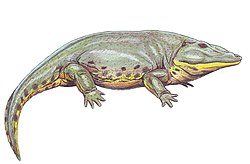| Gonioglyptus Temporal range: | |
|---|---|
| Scientific classification | |
| Domain: | Eukaryota |
| Kingdom: | Animalia |
| Phylum: | Chordata |
| Order: | † Temnospondyli |
| Suborder: | † Stereospondyli |
| Family: | † Trematosauridae |
| Genus: | † Gonioglyptus Huxley, 1865 |
| Species | |
| |
| Synonyms | |
| |
Gonioglyptus is an extinct genus of trematosaurian temnospondyl within the family Trematosauridae. [1] [2] It is known from the Early Triassic Panchet Formation of India. [3] [4] It contains two species: G. longirostris (sometimes classified in the genus Panchetosaurus) [5] and G. fragilis (previously classified in the genus Glyptognathus). [3] The species G. kokeni from Pakistan has since been reclassified into Aphaneramma . [6]



